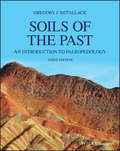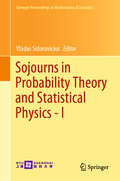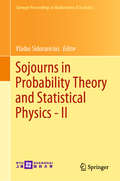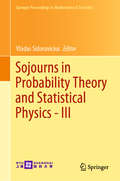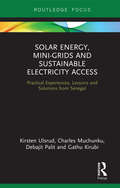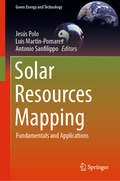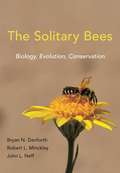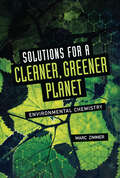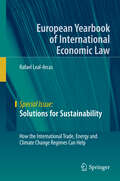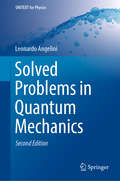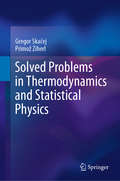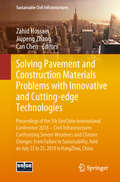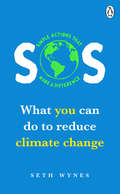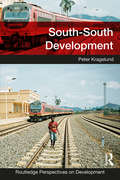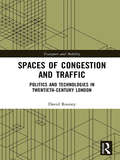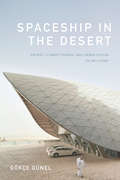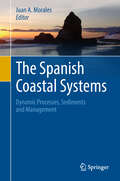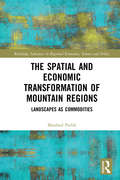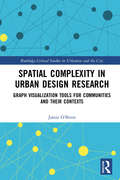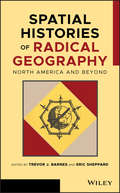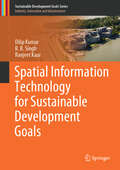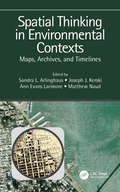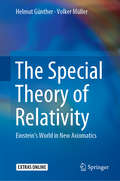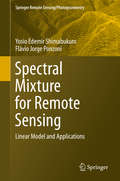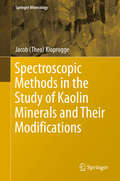- Table View
- List View
Soils of the Past: An Introduction to Paleopedology
by Gregory J. RetallackA student-friendly textbook that describes ancient soils, how they may be identified, and their use in paleoenvironmental reconstruction Ancient soils contain vital mineralogical, geochemical, textural, and paleontological information about the continental environments in which they formed. Advances in isotope geochemistry and sequence-stratigraphic models allow evermore detailed reconstructions of environmental change from paleosols, and new insights into such diverse topics as atmospheric chemistry, global change, paleoecology, geobiology and mass extinction. This book educates readers about the field of paleopedology and how it remains a key area of investigation for geologists and environmental scientists seeking to learn about, and reconstruct, the condition and evolution of paleoenvironments. Presented in three sections—Soils and Palesols; Factors in Soil Formation; and Fossil Record of Soils—Soils of the Past: An Introduction to Paleopedology describes the main types of ancient soil, procedures for identifying and studying them, their classification and, most significantly, a wide array of examples of how paleosols have been used for paleoenvironmental reconstruction. The book is an excellent reflection of the current state of knowledge and can be widely adopted over many disciplines. All chapters have been revised and updated to reflect advances in soil science in the last two decades New tables display a wealth of new data added since the 2nd edition published in 2001 New figures have been added and line art has been redrawn to improve clarity and promote understanding References have been updated throughout Soils of the Past, 3rd Edition is written for advanced undergraduates studying paleopedology as part of a degree in geology, environmental science, or physical geography, and for interested professional earth scientists.
Sojourns in Probability Theory and Statistical Physics - I: Spin Glasses and Statistical Mechanics, A Festschrift for Charles M. Newman (Springer Proceedings in Mathematics & Statistics #298)
by Vladas SidoraviciusCharles M. (Chuck) Newman has been a leader in Probability Theory and Statistical Physics for nearly half a century. This three-volume set is a celebration of the far-reaching scientific impact of his work. It consists of articles by Chuck’s collaborators and colleagues across a number of the fields to which he has made contributions of fundamental significance. This publication was conceived during a conference in 2016 at NYU Shanghai that coincided with Chuck's 70th birthday.The sub-titles of the three volumes are: I. Spin Glasses and Statistical MechanicsII. Brownian Web and PercolationIII. Interacting Particle Systems and Random Walks The articles in these volumes, which cover a wide spectrum of topics, will be especially useful for graduate students and researchers who seek initiation and inspiration in Probability Theory and Statistical Physics.
Sojourns in Probability Theory and Statistical Physics - II: Brownian Web and Percolation, A Festschrift for Charles M. Newman (Springer Proceedings in Mathematics & Statistics #299)
by Vladas SidoraviciusCharles M. (Chuck) Newman has been a leader in Probability Theory and Statistical Physics for nearly half a century. This three-volume set is a celebration of the far-reaching scientific impact of his work. It consists of articles by Chuck’s collaborators and colleagues across a number of the fields to which he has made contributions of fundamental significance. This publication was conceived during a conference in 2016 at NYU Shanghai that coincided with Chuck's 70th birthday.The sub-titles of the three volumes are:I. Spin Glasses and Statistical MechanicsII. Brownian Web and PercolationIII. Interacting Particle Systems and Random WalksThe articles in these volumes, which cover a wide spectrum of topics, will be especially useful for graduate students and researchers who seek initiation and inspiration in Probability Theory and Statistical Physics.
Sojourns in Probability Theory and Statistical Physics - III: Interacting Particle Systems and Random Walks, A Festschrift for Charles M. Newman (Springer Proceedings in Mathematics & Statistics #300)
by Vladas SidoraviciusCharles M. (Chuck) Newman has been a leader in Probability Theory and Statistical Physics for nearly half a century. This three-volume set is a celebration of the far-reaching scientific impact of his work. It consists of articles by Chuck’s collaborators and colleagues across a number of the fields to which he has made contributions of fundamental significance. This publication was conceived during a conference in 2016 at NYU Shanghai that coincided with Chuck's 70th birthday.The sub-titles of the three volumes are:I. Spin Glasses and Statistical MechanicsII. Brownian Web and PercolationIII. Interacting Particle Systems and Random WalksThe articles in these volumes, which cover a wide spectrum of topics, will be especially useful for graduate students and researchers who seek initiation and inspiration in Probability Theory and Statistical Physics.
Solar Energy, Mini-grids and Sustainable Electricity Access: Practical Experiences, Lessons and Solutions from Senegal (Routledge Focus on Environment and Sustainability)
by Debajit Palit Kirsten Ulsrud Charles Muchunku Gathu KirubiThis book presents new research on solar mini-grids and the ways they can be designed and implemented to provide equitable and affordable electricity access, while ensuring economic sustainability and replication. Drawing on a detailed analysis of solar mini-grid projects in Senegal, the book provides invaluable insights into energy provision and accessibility which are highly relevant to Sub-Saharan Africa, and the Global South more generally. Importantly, the book situates mini-grids in rural villages within the context of the broader dynamics of national- and international-level factors, including emerging system innovation and socio-technical transitions to green technologies. The book illustrates typical challenges and potential solutions for practitioners, policymakers, donors, investors and international agencies. It demonstrates the decisive roles of suitable policies and regulations for private-sector-led mini-grids and explains why these policies and regulations must be different from those that are designed as part of an established, centralized electricity regime. Written by both academics and technology practitioners, this book will be of great interest to those researching and working on energy policy, energy provision and access, solar power and renewable energy, and sustainable development more generally.
Solar Resources Mapping: Fundamentals and Applications (Green Energy and Technology)
by Jesús Polo Luis Martín-Pomares Antonio SanfilippoThis book presents methods for optimising the spatial and network configuration of solar radiation measuring stations. Various physical and mathematical models are demonstrated, which together with high quality measurements, provide the essential tools to generate and validate solar resource estimates to improve the mapping of solar resources.Each chapter deals with a specific topic, showing its methodology, and providing examples of how to apply these techniques with reference to current projects around the world. These topics include:· Radiometric measurement campaigns;· Equipment calibration, installation, operation, and maintenance;· Data quality assurance and assessment;· Solar radiation modelling from satellite images and numerical models;· Downscaling and kriging interpolation of solar radiation;· Simulation of electric solar power plant generation;· Solar radiation forecasting;· Applications of solar energy; and· Socio-economic benefits of solar energy.The contributors present the statistical and physical models needed to derive solar radiation from satellite images and numerical models, emphasising the importance of measuring solar radiation accurately. They also show the classical models used to generate synthetic data, clear sky models and ancillary air quality and meteorological data from different input sources.Solar Resources Mapping provides industry professionals with methodologies and tools to build solar irradiance maps for different applications. The book will also benefit students and researchers as it serves as a main technical reference, presenting the basic terminology and fundamentals for solar resource mapping that include methods for assessing measurement uncertainty.
The Solitary Bees: Biology, Evolution, Conservation
by Bryan N. Danforth Robert L. Minckley John L. Neff Frances FawcettThe most up-to-date and authoritative resource on the biology and evolution of solitary beesWhile social bees such as honey bees and bumble bees are familiar to most people, they comprise less than 10 percent of all bee species in the world. The vast majority of bees lead solitary lives, surviving without the help of a hive and using their own resources to fend off danger and protect their offspring. This book draws on new research to provide a comprehensive and authoritative overview of solitary bee biology, offering an unparalleled look at these remarkable insects.The Solitary Bees uses a modern phylogenetic framework to shed new light on the life histories and evolution of solitary bees. It explains the foraging behavior of solitary bees, their development, and competitive mating tactics. The book describes how they construct complex nests using an amazing variety of substrates and materials, and how solitary bees have co-opted beneficial mites, nematodes, and fungi to provide safe environments for their brood. It looks at how they have evolved intimate partnerships with flowering plants and examines their associations with predators, parasites, microbes, and other bees. This up-to-date synthesis of solitary bee biology is an essential resource for students and researchers, one that paves the way for future scholarship on the subject.Beautifully illustrated throughout, The Solitary Bees also documents the critical role solitary bees play as crop pollinators, and raises awareness of the dire threats they face, from habitat loss and climate change to pesticides, pathogens, parasites, and invasive species.
Solutions for a Cleaner, Greener Planet: Environmental Chemistry
by Marc ZimmerMany of the most toxic materials on Earth—from arsenic to plutonium—occur naturally, but manufacturers have also used them in products such as paints, plumbing, pesticides, nuclear fuel, and weaponry. Without careful management, toxins can leach into groundwater or pollute our environment. Exposure to toxins leads to various cancers, impairment of the immune and reproductive systems, as well as cognitive problems. What can be done? Solutions include a wide range of infrastructure approaches, such as better water filtration, governmental and manufacturing regulations, outright bans on certain chemicals, careful monitoring, and the use of alternative fuels. Learn more about key contaminants and their impact on health, as well as solutions on a global and individual level.
Solutions for Sustainability: How the International Trade, Energy and Climate Change Regimes Can Help (European Yearbook of International Economic Law)
by Rafael Leal-ArcasThis book explores links and synergies between international trade and two of the most urgent challenges of the 21st century: achieving sustainable energy (i.e., energy that is affordable, secure, and clean) and mitigating climate change. It takes the unique approach of not only examining how international trade can help achieve energy and climate goals, but also the impact of emerging tools and technologies such as smart grids and demand response, and the potential role and impact of citizens and prosumers. The book analyzes energy- and trade-related regulations in a range of jurisdictions to assess how conducive the regulation is towards achieving sustainable energy, and identifies gaps and overlaps in the existing legal framework.
Solved Problems in Quantum Mechanics (UNITEXT for Physics)
by Leonardo AngeliniThis book presents a large collection of problems in Quantum Mechanics that are solvable within a limited time and using simple mathematics. The problems test both the student’s understanding of each topic and their ability to apply this understanding concretely. Solutions to the problems are provided in detail, eliminating only the simplest steps. No problem has been included that requires knowledge of mathematical methods not covered in standard courses, such as Fuchsian differential equations. The book is in particular designed to assist all students who are preparing for written examinations in Quantum Mechanics, but will also be very useful for teachers who have to pose problems to their students in lessons and examinations.
Solved Problems in Thermodynamics and Statistical Physics
by Gregor Skačej Primož ZiherlThis book contains a modern selection of about 200 solved problems and examples arranged in a didactic way for hands-on experience with course work in a standard advanced undergraduate/first-year graduate class in thermodynamics and statistical physics. The principles of thermodynamics and equilibrium statistical physics are few and simple, but their application often proves more involved than it may seem at first sight. This book is a comprehensive complement to any textbook in the field, emphasizing the analogies between the different systems, and paves the way for an in-depth study of solid state physics, soft matter physics, and field theory.
Solving Pavement and Construction Materials Problems with Innovative and Cutting-edge Technologies: Proceedings of the 5th GeoChina International Conference 2018 – Civil Infrastructures Confronting Severe Weathers and Climate Changes: From Failure to Sustainability, held on July 23 to 25, 2018 in HangZhou, China (Sustainable Civil Infrastructures)
by Zahid Hossain Jiupeng Zhang Can ChenThis book presents challenges in transportation engineering, recent developments and advancements in technologies, and design and construction using sustainable materials. The articles presented in this volume focus on fundamental investigations on various aspects of civil engineering materials and structures. The scope of this volume is the application of findings for solving problems in geotechnical, pavement, and transportation engineering using emerging techniques. Papers were selected from the 5th GeoChina International Conference 2018 on Civil Infrastructures Confronting Severe Weathers and Climate Changes Conference, held on July 23 to 25, 2018 in HangZhou, China.
SOS: What you can do to reduce climate change – simple actions that make a difference
by Seth Wynes'The most effective ways for individuals to reduce their carbon footprint' INewsClimate Change researcher, Seth Wynes, sets out in the simplest terms how you can make a real and positive impact.Make changes at home, at work, to how you shop, eat, live - start by finding one thing your family can change with this book and do it today. What you do matters - and the science proves it. How many actions can you tick of the list in this book to help save our planet?
South-South Development (Routledge Perspectives on Development)
by Peter KragelundSouth-South Development examines the historical background for the current situation: why it suddenly took off again approximately a decade ago; the various vectors of engagement and how they are interrelated; the actors involved; how the revitalisation of South-South development has affected development cooperation ‘as it was’; and finally, how it affects the rest of the Global South. Based on primary research on how Southern actors – via investments, aid, and trade – are changing the face of development both in the Global North and the Global South, this book contextualises the current debates, provides a systematic overview, and brings together the key themes in South-South development. It explains how countries like China, India, and Brazil are influencing domestic politics in other countries of the Global South, how they invest, and how their aid alters power structures between ‘new’ and ‘old’ donors locally. It also explains migration patterns, how they use soft power tools, and how the global governance system is changing as a result of this. This comprehensive and student-focused book includes well developed pedagogy such as text boxes, chapter summaries, key questions, bibliography, weblinks, and annotated further reading. This book offers a unique combination of in-depth insights and secondary data on South-South development, presenting a ‘state-of-the-art’ account of South-South development aimed at students as well as practitioners in disciplines as diverse as International Development Studies, International Relations, Geography, Anthropology, Global Studies, and International Political Economy.
Spaces of Congestion and Traffic: Politics and Technologies in Twentieth-Century London (Transport and Mobility)
by David RooneyThis book provides a political history of urban traffic congestion in the twentieth century, and explores how and why experts from a range of professional disciplines have attempted to solve what they have called ‘the traffic problem’. It draws on case studies of historical traffic projects in London to trace the relationship among technologies, infrastructures, politics, and power on the capital’s congested streets. From the visions of urban planners to the concrete realities of engineers, and from the demands of traffic cops and economists to the new world of electronic surveillance, the book examines the political tensions embedded in the streets of our world cities. It also reveals the hand of capital in our traffic landscape. This book challenges conventional wisdom on urban traffic congestion, deploying a broad array of historical and material sources to tell a powerful account of how our cities work and why traffic remains such a problem. It is a welcome addition to literature on histories and geographies of urban mobility and will appeal to students and researchers in the fields of urban history, transport studies, historical geography, planning history, and the history of technology.
Spaceship in the Desert: Energy, Climate Change, and Urban Design in Abu Dhabi (Experimental Futures)
by Gökçe GünelIn 2006 Abu Dhabi launched an ambitious project to construct the world’s first zero-carbon city: Masdar City. In Spaceship in the Desert Gökçe Günel examines the development and construction of Masdar City's renewable energy and clean technology infrastructures, providing an illuminating portrait of an international group of engineers, designers, and students who attempted to build a post-oil future in Abu Dhabi. While many of Masdar's initiatives—such as developing a new energy currency and a driverless rapid transit network—have stalled or not met expectations, Günel analyzes how these initiatives contributed to rendering the future a thinly disguised version of the fossil-fueled present. Spaceship in the Desert tells the story of Masdar, at once a “utopia” sponsored by the Emirati government, and a well-resourced company involving different actors who participated in the project, each with their own agendas and desires.
The Spanish Coastal Systems: Dynamic Processes, Sediments and Management (Springer Geology)
by Juan A. MoralesThis monograph presents the state of art of the geologic knowledge about the Spanish coast obtained through scientific research in the last 30 years.From a general point of view, coasts are the most quickly changing systems of the Earth. This is critical, since many human resources, such as the main part of economic and social activities, are located in the coastal areas. Especially in the case of Spain these coasts include cities, wide industrial areas (including harbor complexes), important ecologic systems, and our main economic resource: tourism. Understanding the dynamic functioning of each element of this coast is vital for correct future coastal management, so as to solve problems derived from bad plans developed in the last decades of the twentieth century.This is a valuable text for advanced graduate students and coastal researchers, which connects the specific dynamic functioning of the main Spanish coastal environments and their relationships with human activities.
The Spatial and Economic Transformation of Mountain Regions: Landscapes as Commodities (Routledge Advances in Regional Economics, Science and Policy)
by Manfred PerlikMountain regions are subject to a unique set of economic pressures: they act as collective enterprises which have to valorize rare resources, such as spectacular landscapes. While primarily rural in nature, they often border large cities, and the development of industries such as hydroelectric power and the rapid development of tourism can bring about sweeping socio-economic change and vast demographic alterations. The Spatial and Economic Transformation of Mountain Regions describes the socio-economic changes and spatial impacts of the last four decades, with the transformation of mountain areas held up as an example. Much of the real-world context draws on the Alps, spanning as they do the significant economies of France, Italy, Germany, Switzerland, and Austria. Chapters address academic discourse on regional development in these mountain areas and suggest alternative approaches to the liberal-productivist societal model. This book will be essential reading for professionals, institutions, and NGOs searching for counter-models to the existing marketing approaches for peripheral areas. It will also be of interest to students of regional development, economic geography, environmental studies, and industrial economics.
Spatial Complexity in Urban Design Research: Graph Visualization Tools for Communities and their Contexts (Routledge Critical Studies in Urbanism and the City)
by Jamie O’BrienThis book offers state-of-the-art ‘tools for thinking’ for urban designers, planners and decision-makers. Thematically it focuses on the contexts of problems in urban design and places community spaces at the heart of urban design research. The book provides practicable tools for network modelling and visualization in urban design research. Step-by-step examples take readers through methods for tracing the evolution of road networks, and their impacts on contemporary community spaces. Easy-to-follow guides to programming show how to process and plot community data sets as network graphs. They reveal how these can help to observe and represent the different ways in which community spaces are inter-connected. This book places these technological methods in the context of current theories of community formations. It considers how these cutting-edge tools for thinking in urban design research – comprising both theories and methods – could transform our understanding of community spaces as being complex, inter-dependent and socially meaningful assets. This book is pioneering in its analysis of the urban contexts to community formations, and in its argument for professional integration between urban and knowledge practitioners. Academics and professionals within the fields of design research, urban studies, spatial analysis, urban geography and sociology will benefit from reading this book.
Spatial Histories of Radical Geography: North America and Beyond (Antipode Book Series)
by Trevor J. Barnes Eric SheppardA wide-ranging and knowledgeable guide to the history of radical geography in North America and beyond. Includes contributions from an international group of scholars Focuses on the centrality of place, spatial circulation and geographical scale in understanding the rise of radical geography and its spread A celebration of radical geography from its early beginnings in the 1950s through to the 1980s, and after Draws on oral histories by leaders in the field and private and public archives Contains a wealth of never-before published historical material Serves as both authoritative introduction and indispensable professional reference
Spatial Information Technology for Sustainable Development Goals (Sustainable Development Goals Series)
by Dilip Kumar R.B. Singh Ranjeet KaurThis textbook aims to develop a scientific knowledge base on spatial information technology to communicate the United Nations' Sustainable Development Goals (SDGs) among students, researchers, professionals and laymen. The book improves understanding of the spatial database and explains how to extract information from this for planning purposes. To enhance the knowledge of geoscientists and environmentalists, the book describes the basic fundamental concepts to advance techniques for spatial data management and analysis and discusses the methodology. The Geographic Information System (GIS), remote sensing and Global Positioning System (GPS) are presented in an integrated manner for the planning of resources and infrastructure. The management of these systems is discussed in a very lucid way to develop the reader's skills. The proper procedure for map making and spatial analysis are included along with case studies to the reader. Where the first part of the book discusses the conceptual background, the second part deals with case studies using these applications in different disciplines. The presented case studies include land use, agriculture, flood, watershed characterization and infrastructure assessment for the Sustainable Development Goals.
Spatial Thinking in Environmental Contexts: Maps, Archives, and Timelines
by Sandra L. Arlinghaus Joseph J. Kerski Ann Evans Larimore Matthew NaudSpatial Thinking in Environmental Contexts: Maps, Archives, and Timelines cultivates the spatial thinking "habit of mind" as a critical geographical view of how the world works, including how environmental systems function, and how we can approach and solve environmental problems using maps, archives, and timelines. The work explains why spatial thinking matters as it helps readers to integrate a variety of methods to describe and analyze spatial/temporal events and phenomena in disparate environmental contexts. It weaves together maps, GIS, timelines, and storytelling as important strategies in examining concepts and procedures in analyzing real-world data and relationships. The work thus adds significant value to qualitative and quantitative research in environmental (and related) sciences. Features Written by internationally renowned experts known for taking complex ideas and finding accessible ways to more broadly understand and communicate them. Includes real-world studies explaining the merging of disparate data in a sensible manner, understandable across several disciplines. Unique approach to spatial thinking involving animated maps, 3D maps, GEOMATs, and story maps to integrate maps, archives, and timelines—first across a single environmental example and then through varied examples. Merges spatial and temporal views on a broad range of environmental issues from traditional environmental topics to more unusual ones involving urban studies, medicine, municipal/governmental application, and citizen-scientist topics. Provides easy to follow step-by-step instructions to complete tasks; no prior experience in data processing is needed.
The Special Theory of Relativity: Einstein’s World in New Axiomatics
by Helmut Günther Volker MüllerThis book discusses in detail the special theory of relativity without including all the instruments of theoretical physics, enabling readers who are not budding theoretical physicists to develop competence in the field. An arbitrary but fixed inertial system is chosen, where the known velocity of light is measured. With respect to this system a moving clock loses time and a moving length contracts. The book then presents a definition of simultaneity for the other inertial frames without using the velocity of light. To do so it employs the known reciprocity principle, which in this context serves to provide a definition of simultaneity in the other inertial frames. As a consequence, the Lorentz transformation is deduced and the universal constancy of light is established. With the help of a lattice model of the special theory of relativity the book provides a deeper understanding of the relativistic effects. Further, it discusses the key STR experiments and formulates and solves 54 problems in detail.
Spectral Mixture for Remote Sensing: Linear Model and Applications (Springer Remote Sensing/Photogrammetry)
by Yosio Edemir Shimabukuro Flávio Jorge PonzoniThis book explains in a didactic way the basic concepts of spectral mixing, digital numbers and orbital sensors, and then presents the linear modelling technique of spectral mixing and the generation of fractional images. In addition to presenting a theoretical basis for spectral mixing, the book provides examples of practical applications such as projects for estimating and monitoring deforested areas in the Amazon. In its seven chapters, the book offers remote sensing techniques to understand the main concepts, methods, and limitations of spectral mixing for digital image processing. Chapter 1 addresses the basic concepts of spectral mixing, while chapters 2 and 3 discuss digital numbers and orbital sensors such as MODIS and Landsat MSS. Chapter 4 details the linear spectral mixing model, and chapter 5 talks about how to use this technique to create fraction images. Chapter 6 offers remote sensing applications of fraction images in deforestation monitoring, burned-area mapping, selective logging detection, and land-use/land-cover mapping. Chapter 7 gives some concluding thoughts on spectral mixing, and considers future uses in environmental remote sensing. This book will be of interest to students, teachers, and researchers using remote sensing for Earth observation and environmental modelling.
Spectroscopic Methods in the Study of Kaolin Minerals and Their Modifications (Springer Mineralogy Ser.)
by Jacob Theo KloproggeThis book systematically provides an overview of the use of a wide range of spectroscopic methods (Mid- and Near-Infrared, Infrared Emission, Raman, Solid-State Magic Angle Spinning Nuclear Magnetic Resonance, X-ray Photoelectron, Extended X-ray Absorption Fine Structure, X-ray Absorption Near Edge, Electron Spin and Mössbauer spectroscopy) to investigate kaolin minerals (kaolinite, dickite, nacrite and halloysite) and their modifications (intercalation compounds, nanocomposites and other modifications).
